Roughly one-half of the movie “Oppenheimer” focuses on the unjust way Robert J. Oppenheimer, the father of the atomic bomb, was persecuted after he performed so spectacularly in heading up Los Alamos and giving the United States the atomic bomb to end World War II in Japan. Oppenheimer was denied a security clearance during kangaroo court hearings in 1954, which basically meant he could no longer work in his field. He continued to lecture, but he was ruined.
Director Christopher Nolan has made one of the—if not THE—most important film in a very important career. This $100 million depiction of how the United States came to create the atomic bomb at Los Alamos is a dense subject. The movie was based on the 2006 Pulitzer Prize winning book “American Prometheus: The Triumph and Tragedy of J. Robert Oppenheimer” by Kai Bird and Martin J. Sherwin (2005). Prometheus, of course, was the god who gave fire to mankind. For his crime he was chained to a rock and a vulture ate his liver each day, which grew back each night.
There are so many characters in the book and it appears that Nolan has attempted to wrap his creative mind around all of them and present every character onscreen. I applaud him for taking the dense text and transforming it into this three-hour epic film. The “L.A. Times” critic said: “Arguably Nolan’s most impressive work yet in the way it combines his acknowledged visual mastery with one of the deepest character dives in recent American cinema.”
At three hours, it’s a long film.
It’s deep, all right.
I felt fairly dense myself after trying to follow all of the twists and turns in the plot. I was especially ill-prepared when it comes to quantum physics, having dropped out of Physics in high school after two days. (That act was almost a replay of “Peggy Sue Got Married” where Kathleen Turner gets up from an algebra test and announces that she happens to know that she will never need this stuff in the future.)
VISUALLY
The movie, shot on 70 mm film, has stunning imagery, especially in the early parts. (Later sections that deal with the security clearance hearings in offices are more black-and-white). I was immediately reminded of the sweeping panoramas of filmmakers like Terrence Malick (“Days of Heaven,” “Tree of Life”), or David Lean (“Dr. Zhivago”), or Stanley Kubrick (“2001: A Space Odyssey”). No less a movie maven than author David Morrell commented on the different color palettes employed throughout the film.
The movie does not show the actual dropping of the atomic bombs on Hiroshima and Nagasaki, which killed 220,000 people, but, instead, gives us the test explosion in New Mexico, called Trinity. Cinematographer Hoyte Van Hoytema deserves Oscar nominations for his work. I disagree with the critic who said you didn’t need to see this one on the IMAX big screen. If ever there was an argument for IMAX, a film like this is it. (Last one I shelled out for IMAX treatment was the remake of “West Side Story.”)
If I may wander from the actual film’s words for a moment, supposedly Oppenheimer’s brother, Frank, also a nuclear physicist (who was also hounded from the field) said that his brother’s words after the test were, “I guess it works.” That is not in the film. But the lines that do appear, with Matt Damon and others articulating them, describe the after-effects of the Trinity test blast. Says a witness to the Trinity blast, “I hope you learned something.” To which Matt Damon’s character responds, “We learned we’re going to need to be lots further away!”
That’s about as close to humor as this film will get.
CAST
Cillian Murphy, who visually resembles Oppenheimer (and was actually up for the lead role in a previous Oppenheimer treatment), has worked with Nolan on 6 films. He uses his preternaturally large blue eyes to good advantage in portraying this tortured genius. Murphy supposedly subsisted on a diet of fruits, nuts and figs and very little else to keep the elfin stature of the real man intact throughout filming. In real life, Oppenheimer was said to often forget to eat, so that seems apropos.
The number of Oscar-winning or nominated actors in the film is a tribute to the director’s stature. I will probably accidentally omit someone, but Robert Downey, Jr., is bound to be an Oscar nominee for his pivotal role as Lewis Strauss, the two-faced politician who set Oppenheimer up for ruin because of personal animus and Cillian Murphy comes into his own as a leading man.
Others in the cast include Josh Hartnett in a welcome return to form, Gary Oldman, Kenneth Branagh, Tom Conti (who plays Einstein), Matthew Modine, Alden Ehrenreich, Casey Affleck, Rami Malek, Emily Blunt, Florence Pugh, Tony Goldwyn, James D’Arcy, Jason Clarke and Matt Damon. I’m sure I’ve forgotten some of the bigger “name” actors or actresses, but the wealth of talent is very deep when you’re casting an Oscar winner like Malek in a small part. All of the actors complimented Nolan, the mastermind. Some critics have mentioned the relatively meager parts for women, as opposed to the meatier male roles. This “it’s a man’s world” depiction is true to the period, however.
Personally, I related to the four-times married Kitty (Emily Blunt), shown at her wit’s end with two squalling toddlers and stuck in the quickly thrown-together town built for the Manhattan Project scientists in Los Alamos. She mentions that there is “no kitchen” upon being shown the house for the first time.
Oppenheimer had his hands full with prima donna scientists who constantly quit or are in conflict, but Kitty was stuck in the house with two extremely colicky kids. Baby Peter is even taken to a friend’s house by his father when his constant crying becomes too much for the couple. Younger daughter Katherine (“Toni”), who was born at Los Alamos in November of 1944 is only seen as an infant in the film. She grew up and studied to be a United Nations interpreter but was denied a security clearance because of her father’s fifties security clearance hearings. This was 10 years after Oppenheimer’s 1967 death from throat cancer. In 1977, after that denial, Toni—who had inherited the St. Thomas cottage where her parents lived in later life, hanged herself. She left the family cottage and grounds to St. Thomas for the use of the public.
PERSONAL LIVES
Oppenheimer was a World Class womanizer. Matt Damon has an exchange with Oppenheimer where he says, “You’re a dilettante, you’re a womanizer, unstable, theatrical, neurotic!” Oppenheimer’s affair with Florence Pugh (virtually unrecognizable with dark hair) portraying paramour Jean Tatlock causes much conflict in the film. The couple see each other shortly after Oppenheimer’s second child is born.
A troubled soul who ultimately committed suicide, Jean Tatlock WAS a Communist. This bit of personal information on Oppenheimer’s affair was brought out during the 1954 kangaroo court hearings with Oppenheimer’s wife Kitty (Emily Blunt) sitting there to hear it, as Oppenheimer is interrogated by Jason Clarke (“Pet Semetary”). Still, Kitty and J. Robert stayed together.
Lewis Strauss (Robert Downey, Jr.) pretended, to Oppenheimer’s face, to be a friend. He was as two-faced as they come and set Oppenheimer up for his fall, out of vindictive animus. Strauss (who was angling to become the Secretary of Commerce) felt he had been held up to ridicule during testimony that Oppenheimer gave. One dispute was over the exporting of radioactive isotopes to Sweden. The testimony used in the screenplay showed Oppenheimer saying that radioactive isotopes were “less important than electronic devices, but more important than, let us say, vitamins.” In the screenplay the comparison became “a bottle of beer.”
Another change from reported wording seemed to be in what President Truman (portrayed by Gary Oldman) actually said after meeting with Oppenheimer in the Oval Office. In the movie, Oppenheimer tells Truman that he feels he has “blood on his hands.” This is because of how conflicted Oppenheimer is regarding the death of 220,000 Japanese civilians when the bomb was dropped. Oppenheimer is urging (somewhat naively) international cooperation on the use of nuclear weapons, with an entity like the United Nations in charge. The generals and the Army and the politicians do not see it his way.
Truman, during a visit with Oppenheimer in the Oval Office, hands him a handkerchief after his comment about regulating nuclear weapons internationally and then, when Oppenheimer walks out of the Oval Office, tells his Undersecretary of State, Dean Acheson, “I don’t want to see that son-of-a-bitch in this office ever again.” In the movie, the script has Truman saying, “Don’t let that crybaby back in here.” The profanity is probably more accurate, because Truman was known for his salty language. (They didn’t call him “give-’em- hell-Harry” for nothing.)
MORAL VACILLATION
Oppenheimer vacillated over his feelings of guilt over the deaths in Hiroshima and Nagasaki from the dropping of the bomb he created.
After the successful drop. The screenplay has him telling a jubilant room full of Los Alamos employees, “It’s too soon to determine the results of the bombing, but I’ll bet the Japanese didn’t like it. I just wish we had had it to use against the Germans.”
At another point in the plot, this line appears, “Nobody knows what you believe. Do you?”
Repeated throughout the piece, however, is this refrain: “Just because we’re building it doesn’t mean that we get to decide how it is used.”
Matt Damon’s character, General Leslie Groves, tells Oppenheimer, “We’ve given them an Ace. It’s for them to play the hands.” Another repetition of this thought: “The fact that we built this bomb does not give us the right or responsibility to determine how it is used.” All of these lines seemed to be justifications. After all, Oppenheimer was the American Prometheus, “the man who gave the Americans the ability to destroy themselves.” As Nolan says at another point in the screenplay which he wrote, “The day will come when people will curse the name Los Alamos.”
MUSIC
Leslie Goranssen’s music has been singled out as one of the best scores of the year (Oscar?.) Terms like “masterful” and “mercurial” were used. I kept noticing how many of the scenes that had subtle background music would be totally unremarkable without his musical contribution. The use of stamping feet was unique and original.
OVERALL
For tension, structure, sense of scale, startling sound design (very impressive when viewed in IMAX) and remarkable visuals—not to mention the superb cast of actors—this one is going to be hard to beat. Yes, it is overlong and dense and made me feel woefully inadequate to understand the quantum physics discussed, but phrases like “Power exists in the shadows” were universal and I had to agree with the remark attributed to Wernher von Braun, who said, of Oppenheimer’s poor treatment by Lewis Strauss and the bureaucracy, “In England, Oppenheimer would have been knighted.”
On a personal level, since Wehrner Von Braun of Hitler’s rocket program ultimately ended up in Iowa City, Iowa (my alma mater) for the remainder of his life after fleeing Nazi Germany, I thoroughly agree.
I have personally met and spoken with at least five of the actors/actresses onscreen in “Oppenheimer” at various film festivals, those being Gary Oldman (in Chicago for “Soldier, Sailor, Tinker, Spy” in 2011), Kenneth Branagh (in Chicago with “Belfast” in 2021), Casey Affleck (in Chicago with “Gone, Baby, Gone” in 2007), Emily Blunt, in Austin at SXSW for “A Quiet Place” (2018), and Jason Clarke at SXSW for the remake of “Pet Sematary” (2019).
It seems fitting to end the review of this extraordinary film with the quotation from the Bhagavad Gita that Oppenheimer repeats, “Now I am become Death, the destroyer of worlds.”



 When you go to the nail shop in Austin, you are surrounded by technicians who mainly speak to one another in Vietnamese (at least, I think it’s Vietnamese). Otherwise, you have only the large flat-screen television to occupy you. I learned that Annette
When you go to the nail shop in Austin, you are surrounded by technicians who mainly speak to one another in Vietnamese (at least, I think it’s Vietnamese). Otherwise, you have only the large flat-screen television to occupy you. I learned that Annette 
 When you couple the above news with
When you couple the above news with  I was recently offered a deal where I could stream old classic movies for a monthly fee. It was suggested to me, in particular, because I review film, and, of course, how could I be “up” on ALL the movies of the past. (How could ANYONE be “up” on all the movies of the past, is more like it; I think I’m pretty solid on anything from 1955 on, but I’ve been outsourcing the Marvel epics.)
I was recently offered a deal where I could stream old classic movies for a monthly fee. It was suggested to me, in particular, because I review film, and, of course, how could I be “up” on ALL the movies of the past. (How could ANYONE be “up” on all the movies of the past, is more like it; I think I’m pretty solid on anything from 1955 on, but I’ve been outsourcing the Marvel epics.)

